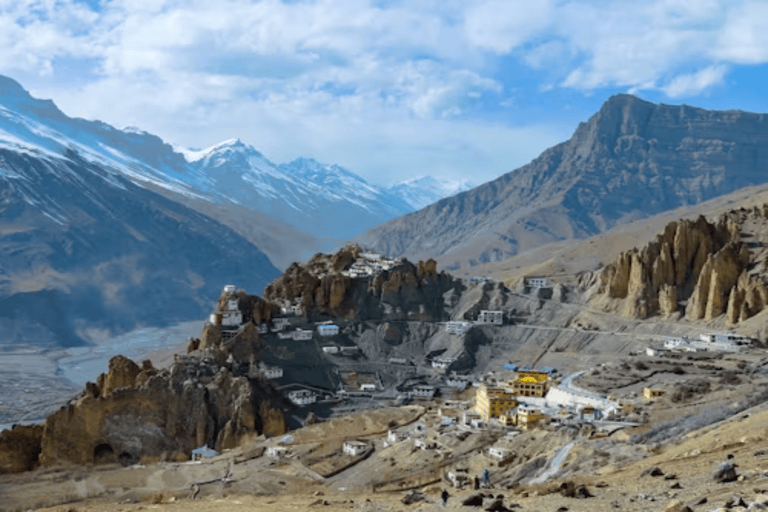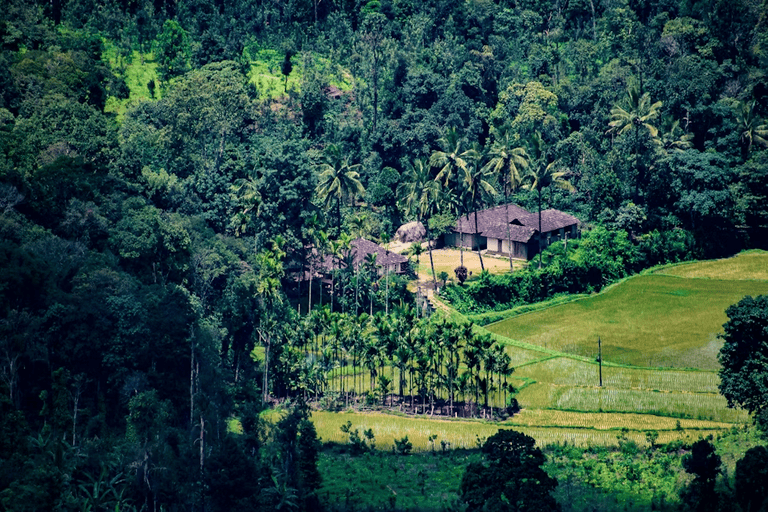
Ancient Wonders: Unveiling the Mystical Temples of Angkor Wat in Cambodia
Table of contents
Nestled deep within the lush, tropical forests of northwestern Cambodia lies one of the most remarkable and enigmatic architectural wonders of the ancient world— Angkor Wat. This colossal temple complex, built in the early 12th century, stands as a testament to the grandeur and ingenuity of the Khmer Empire, which once reigned over vast swaths of Southeast Asia.
Angkor Wat is more than just a single temple; it is a vast, interconnected network of structures that encompass an area of over 500 acres. The central temple, which stands as the iconic symbol of Cambodia, is a true masterpiece of engineering and design, rising 213 feet (65 metres) into the air and featuring five distinctive towers that represent the five peaks of Mount Meru, the mythical home of the Hindu gods.
But Angkor Wat is not merely an impressive feat of construction; it is also a deeply spiritual and symbolic site, imbued with layers of meaning and significance that have captivated scholars, historians, and travelers for centuries.
Angkor Wat History and Origin

Angkor Wat History and Origin
The origins of Angkor Wat can be traced back to the reign of King Suryavarman II, who ruled the Khmer Empire from 1113 to 1150 CE. During this time, the Khmer Empire was at the height of its power, with a vast network of cities, temples, and infrastructure that stretched across much of mainland Southeast Asia.
Suryavarman II, a devout Hindu, commissioned the construction of Angkor Wat as a temple dedicated to the god Vishnu. The choice of Vishnu as the temple’s patron deity was not arbitrary; Suryavarman II saw himself as a “god-king,” a divine ruler who was the earthly incarnation of Vishnu, the preserver of the universe.
The construction of Angkor Temple was a massive undertaking, involving thousands of workers and taking several decades to complete. The temple complex was designed with meticulous attention to detail, with each element carefully planned and executed to create a unified, harmonious whole.
One of the most remarkable aspects of Angkor Wat’s design is its orientation. Unlike most Hindu temples, which are typically oriented towards the east, Angkor Wat faces west. This unusual orientation has been the subject of much scholarly debate, with some researchers suggesting that it may have been aligned with the setting sun, reflecting the temple’s connection to the cycle of life and death.
As the Khmer Empire continued to flourish, Angkor Wat underwent a series of transformations. In the late 12th century, the temple was converted from a Hindu to a Buddhist site, with the addition of new shrines and the incorporation of Buddhist imagery and iconography. This religious shift reflected the changing religious landscape of the region as the influence of Theravada Buddhism grew alongside the traditional Hindu beliefs of the Khmer people.
Despite these changes, Angkor Wat remained a central and revered site within the Khmer Empire, serving as a hub of religious, political, and cultural activity. The temple complex was surrounded by a vast network of other temples, palaces, and infrastructure, all of which were carefully integrated into the overall plan of the city of Angkor.
The Decline and Rediscovery of Angkor Wat
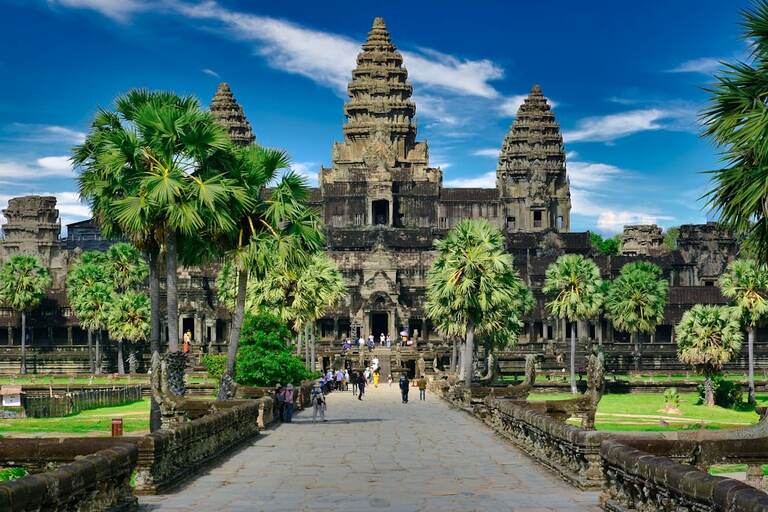
The Decline and Rediscovery of Angkor Wat
In the early 15th century, the Khmer Empire began to decline, and Angkor Wat was gradually abandoned and reclaimed by the surrounding jungle. For centuries, the once-mighty temple complex lay forgotten, its intricate carvings and towering spires obscured by a dense tangle of vegetation.
It wasn’t until the 19th century that Angkor Wat was rediscovered by Western explorers and scholars. In 1840, French naturalist and explorer Henri Mouhot stumbled upon the ruins of Angkor Wat while travelling through the Cambodian countryside. Mouhot was immediately struck by the grandeur and beauty of the temple complex, and his accounts of his discoveries sparked a renewed interest in the ancient Khmer civilization.
Over the following decades, a steady stream of Western researchers, archaeologists, and conservationists flocked to Cambodia to learn more about Angkor Wat Temple, drawn by its allure and the mysteries that lay hidden within its ancient walls. These early efforts to study and preserve the temple complex laid the groundwork for the extensive restoration and conservation work that continues to this day.
Architectural and Artistic Wonders of Angkor Wat
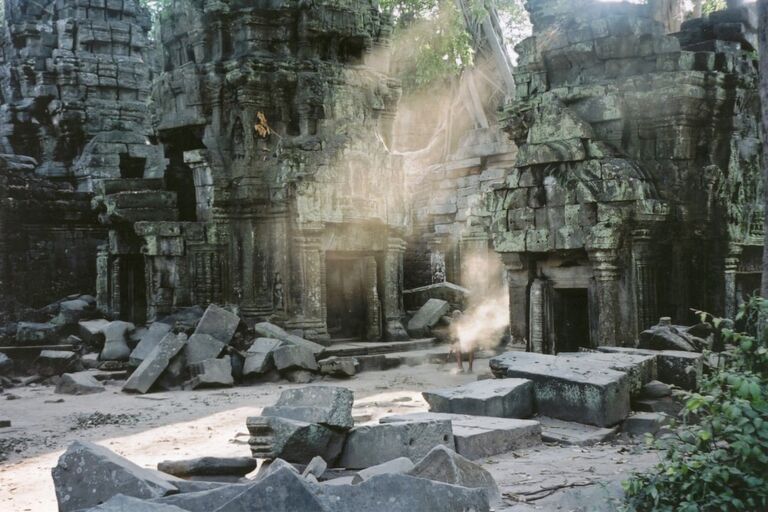
Architectural and Artistic Wonders of Angkor Wat
Angkor Wat is a true architectural masterpiece, a testament to the ingenuity and craftsmanship of the Khmer people. The temple complex is characterized by its distinctive, towering spires, which rise up in a series of five concentric squares, each representing a different level of the Hindu cosmos.
At the heart of Angkor Wat is the central temple, which is surrounded by a series of moats and galleries that serve both practical and symbolic purposes. The outer moat, for example, is thought to represent the cosmic ocean, while the inner moat may have been used for ritual purification ceremonies.
Another remarkable feature you can notice when you take the Angkor Wat Temple tour is its use of symmetry and proportion. The entire complex is laid out in a highly organized and deliberate manner, with each element carefully designed to complement the others and create a sense of harmony and balance.
This attention to detail extends to the interior of these Cambodia temples as well. Its intricate carvings and the play of light and shadow that filters through the doorways and windows characterize the central sanctuary, which once housed a large statue of Vishnu.
Beyond the central temple, Angkor Wat is surrounded by a series of smaller satellite temples, shrines, and other structures, each of which adds to the overall richness and complexity of the site. These structures include libraries, pavilions, and even a series of artificial lakes and waterways that were used for ritual purposes.
Read More : 12 Best Places To Visit In Cambodia
The Carved Bas-Reliefs of Angkor Wat

The Carved Bas-Reliefs of Angkor Wat
One of the most awe-inspiring and captivating features of the Angkor temple complex are the intricate, detailed bas-relief carvings that adorn the walls and galleries of the site. These elaborate stone carvings, spanning over 600 metres in total length, offer a remarkable window into the rich mythological and historical narratives that were central to the Khmer civilization.
The bas-reliefs of Angkor Wat are not merely decorative elements; they are masterful works of art that seamlessly blend Hindu iconography, Khmer history, and scenes of everyday life. Each carving is a vivid and immersive depiction, inviting visitors to step into the vibrant world of the Khmer Empire and explore the beliefs, values, and experiences that defined this ancient civilization.
Mythological Narratives: The Churning of the Sea of Milk
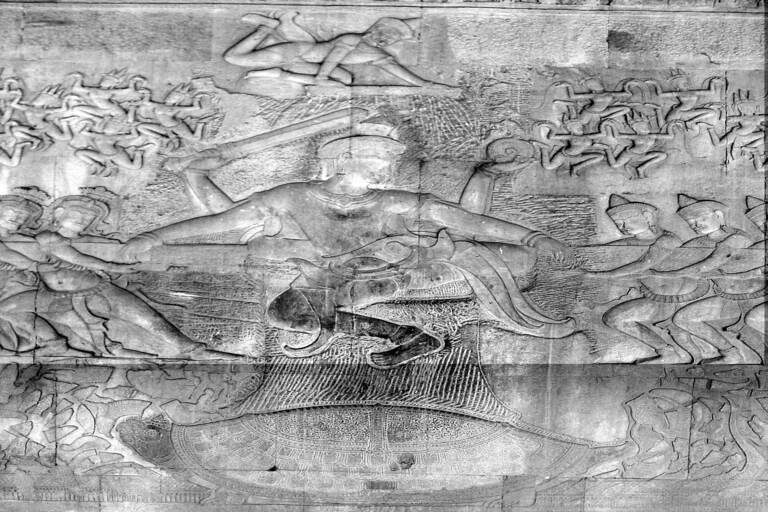
The Churning of the Sea of Milk
Perhaps the most renowned of Angkor Wat’s bas-reliefs is the “Churning of the Sea of Milk,” which you can find on the western gallery of the outer enclosure when you take Angkor Wat temple tour. This remarkable carving, spanning over 49 metres in length, depicts a scene from the Hindu creation myth in which the gods and demons work together to churn the cosmic ocean, using a giant serpent as a rope, in order to extract the elixir of immortality.
The level of detail and dynamism in this carving is truly breathtaking. Hundreds of figures, both divine and demonic, are shown straining and pulling with all their might. Their expressions and poses convey the intense physical effort of the task. Overhead, the gods and celestial beings watch the scene unfold, their presence adding a sense of cosmic significance to the proceedings.
The “Churning of the Sea of Milk” is not just a masterful work of art; it is also a powerful symbolic representation of the cyclical nature of creation and destruction that lies at the heart of Hinduism. The act of churning the ocean, with its resulting extraction of both the elixir of immortality and deadly poison, reflects the eternal dance of life and death, light and dark, that is central to Hindu cosmology.
A Temple Mountain Reaching for the Divine
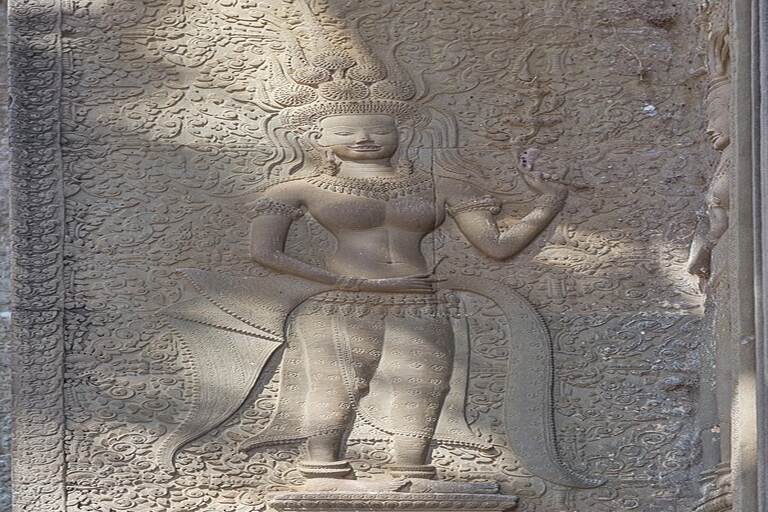
A Temple Mountain Reaching for the Divine
Angkor Wat’s architectural design is a remarkable feat of engineering and symbolic representation. At its core, the temple complex is designed as a “temple mountain,” a physical embodiment of the mythical Mount Meru, the cosmic mountain that serves as the abode of the Hindu deities.
The five towers of the central temple, rising 213 feet into the sky, symbolize the five peaks of this sacred mountain, connecting the earthly realm to the heavens above. This vertical integration of the physical and the spiritual is a hallmark of this Cambodian temple’s design, reflecting the Khmer’s deep reverence for the divine and their aspiration to forge a connection between the mortal and the immortal realms.
Angkor Wat as a Cosmic Mandala
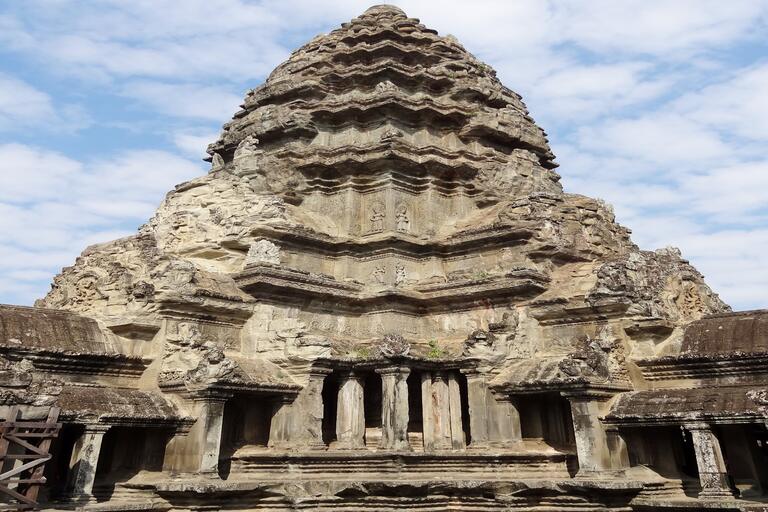
Angkor Wat as a Cosmic Mandala
The layout and design of the Angkor temple can be understood as a vast, three-dimensional mandala—a sacred geometric representation of the Hindu and Buddhist cosmological universes. The temple’s concentric moats, galleries, and towers mirror the intricate, layered structure of the mandala, with the central sanctuary at the heart symbolising the axis mundi, the sacred point where the earthly and divine realms converge.
This mandala-like organisation imbues Angkor Wat with a profound sense of sacred geometry, guiding visitors on a symbolic journey from the earthly to the transcendent. Through its architectural mandala, the temple complex offers a tangible manifestation of the Khmer’s spiritual worldview, inviting pilgrims and visitors alike to engage with the divine.
Read More : Vietnam and Cambodia – Backpackers Second Home
Angkor Wat Today: A Timeless Wonder Preserved

A Timeless Wonder Preserved
Despite the passage of centuries, Angkor Wat continues to captivate and inspire visitors from around the world. Today, this UNESCO World Heritage Site remains a powerful symbol of Cambodia’s rich cultural heritage and an enduring testament to the ingenuity and craftsmanship of the Khmer people. Through ongoing conservation efforts, the temple complex has been painstakingly restored and preserved, allowing visitors to immerse themselves in the grandeur and mystique of this ancient wonder.
From the intricate bas-reliefs to the soaring towers, every aspect of Angkor Wat continues to awe and enchant, revealing layer upon layer of historical, cultural, and spiritual significance. As a living monument to the enduring human spirit, Angkor Wat stands as a timeless beacon, inviting us to explore the depths of our shared past and the limitless possibilities of the future.
Angkor Wat Temple Tickets
Managed by the Angkor Enterprise, a government agency, the temple offers several ticket options for visitors:
- Single Day Pass:
- Allows entry to the Angkor Archaeological Park for one day.
- Costs $37 for adults and $18.50 for children (under 12 years old).
- Three-Day Pass:
- Grants access to the Angkor Archaeological Park for three days within a week.
- Costs $62 for adults and $31 for children.
- Seven-Day Pass:
- Provides entry to the Angkor Archaeological Park for seven days within a month.
- Costs $72 for adults and $36 for children.
All Angkor Wat tickets can be purchased online through the Angkor Enterprise website or at the designated ticket offices located near the park’s entrances. Visitors are advised to bring their passports or identification documents for verification when purchasing tickets.
Angkor Wat is more than just a remarkable architectural and artistic achievement. It is a site of deep spiritual and cultural significance that continues to captivate and inspire people around the world.
For the Khmer people, the Angkor temple has long been a symbol of national identity and pride, a tangible reminder of the glory and power of their ancient civilization. The temple complex is deeply embedded in the cultural and religious traditions of Cambodia, and it continues to be an important site of pilgrimage and ritual for Buddhists and Hindus alike.
Today, Angkor Wat remains one of the most iconic and recognisable landmarks in Southeast Asia, and it continues to draw millions of visitors each year. The site has been the subject of extensive research and conservation efforts, with scholars and experts from around the world working to unravel the mysteries and preserve the legacy of this remarkable ancient wonder. Despite the many challenges and setbacks that have been faced over the centuries, Angkor Wat has endured as a testament to the resilience and creativity of the human spirit.
Embark on a captivating journey through the ancient ruins of Angkor Wat. With Thomas Cook’s expertly curated Cambodia Tour Packages, immerse yourself in the rich history and awe-inspiring architecture of this UNESCO World Heritage gem. Explore the colossal temple complexes, marvel at the intricate carvings, and gain insights into the fascinating Khmer civilization that once thrived here.
Table of contents
Trending blogs for you
 18002099100
18002099100
















